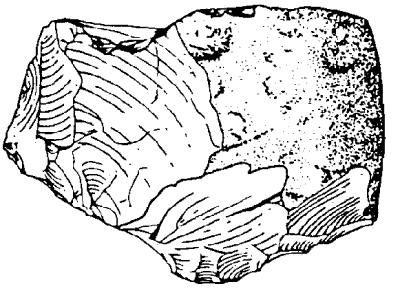 |
Science Frontiers ONLINE No. 108: Nov-Dec 1996 |
|
|
Deflating a paradigm: brazil's pedra furada
The paradigm. The New World was peopled from Asia by migration across the Bering Land Bridge about 12,000 years ago, or perhaps a wee earlier.
The Pedra Furada site has been dated at 50,000 BP by N. Guidon and her team of archeologists. This challenge to the dominant paradigm is powerful and unambiguous. Picking up the gauntlet, several more-conservative archeologists visited the Brazilian site and penned a blistering critique in Antiquity. (Ref. 1) Their major contention was that the 500+ supposedly human-made stone "artifacts" collected by Guidon's team are actually "geofacts"; that is, they were chipped and flaked naturally as rocks fell one upon the other from nearby cliffs. We discussed this problem in some detail in SF#105. Several other reservations about the Pedra Furada work are also offered in Ref. 1.
The reaction of Guidon et al to the Antiquity paper was thunderous to say the least. It revealed the depth of the chasm separating archeologists on the date of human occupation of the New World as well as internecine politics in archeology. (Ref. 2)
Guidon et al flung two serious charges at the authors of the first Antiquity paper: (1) They had their facts all wrong; and (2) Their objectivity was distorted by their loyalty to the aforestated paradigm. Not withholding any punches, N. Guidon and A.-M. Pessis entitled their opening broadside: "Falsehood or Untruth"! They wrote:
"The article by Meltzer et al (1994) is based on partial data and false information (highlighted below). Its battery of questions takes us by surprise; none of the three colleagues came up with these questions during the 1993 meeting -- mounted precisely to generate direct dialogue on the peopling of the America. We disagree with their statement, 'the comments on Pedra Furada are not offered lightly' (p. 696). The commentaries are worthless because they are based on partial and incorrect knowledge.
"We believe that the initial intention of the authors was different; they got carried away into an exercise in academic style, from a fragile scientific base of fragmentary data and with a skepticism born of a subjective conviction." (Ref. 2)
In the world of science, these are serious charges. Guidon and Pessis go on to dismiss each complaint made by Meltzer et al in Ref. 1. As for the "geofact" hypothesis, Guidon and Pessis point to two of the illustrations used by Meltzer et al, remarking:
"The artefact in their figures 9 & 10 has five successive parallel flakescars on the same edge. By the authors' hypothesis, it will have suffered the first when it fell; thereafter, four other pebbles fell on top of it, one beside the other, regularly, causing flake-scars with equal technical characteristics."
Sounds unlikely, doesn't it -- even if 50,000 years are allowed. And there are over 500 such "serial accidents."
Ref. 1. Meltzer, D.J., et al; "On a Pleistocene Human Occupation at Pedra Furada, Brazil," Antiquity, 68:695, 1994.
Ref. 2. Guidon, N., et al; "Nature and Age of the Deposits in Pedra Furada, Brazil: Reply to Meltzer, Adovasio & Dillehay," Antiquity, 70:408, 1996.
Comment. Continuing our SF#105 analogy between geofacts and biological organisms -- both supposedly products of random processes and subsequent selection -- we ask how long it would take for enough random mutations to accumulate, in the proper order (as with the geofact flake scars) to evolve a new species, with the help of natural selection (corresponding to Guidon et al sorting out their flaked stones)? Millions of years? But perhaps that much time was not available. See under BIOLOGY the two items on the rapidly evolving ciclid fishes of Lake Victoria and "intelligent" genomes.
 | Crude stone tools like this are certain signs of human presence -- except when paradigms dictate otherwise! This one is a "bona fide" tool from New Guinea. |